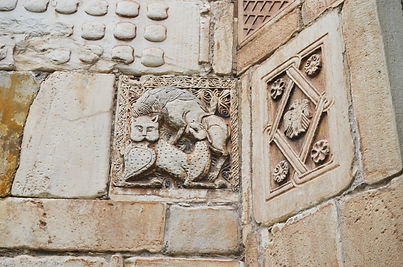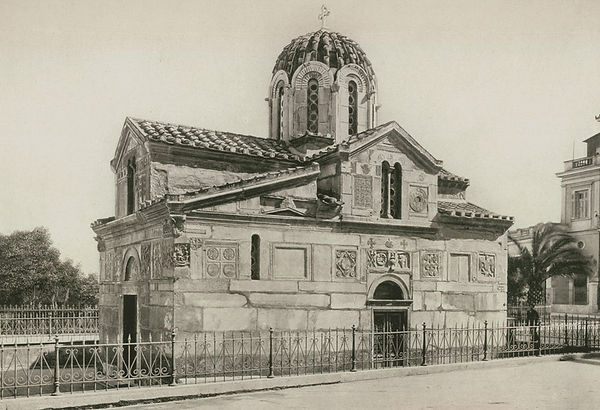Panagia Gorgoepikoos (Athens)
The Panagia Gorgoepikoos is also known as the Little Metropolis because in the eighteenth century it stood within the enclosure of the Archbishopric of Athens, and during that time it served as the metropolitan church. Yet its original name is the Panagia Gorgoepikoos, the Virgin Who Grants Requests Quickly. This attribute stems from a miracle-working icon of the Virgin that is the church's most prized possession. The Archbishopric and the Panagia Gorgoepikoos were abandoned during the Greek War of Independence, and the church remained unused for two decades. Then in 1841 it was converted into a library, a function that it continued to serve until 1868, when it was reconsecrated as a Christian sanctuary. At that time it was dedicated to Christ the Saviour, but after a few years that name fell out of use and it came to be called the church of Hagios Eleutherios. However, architectural historians continue to refer to it by its original name, the Panagia Gorgoepikoos. The church was restored in 1856 (and again more recently), when the modem bell-tower and all later accretions were removed, so that the structure we see today is in essentially its original state.
Most authorities date the church to the twelfth or thirteenth century, although some authorities and local tradition attribute its founding to the Empress Irene, who was born in Athens and ruled the Byzantine Empire in her own right during the years 797-802. But this tradition can probably be discounted, for Irene is credited with founding several of the Byzantine churches of Athens, and in no case is there any evidence to substantiate the claim. In any event, there is definite evidence that there was an earlier church on this site, a structure that has been dated to c. 600, for many of its stones have been built into the present structure. In fact, the walls of the Panagia Gorgoepikoos are constructed entirely of ancient marble blocks, many of which are decorated with interesting inscriptions and reliefs. These reliefs are the most fascinating aspect of the church, for they make it a veritable museum of decorative stonework, dating from the classical period up through the medieval Byzantine and Latin eras.
The church is quite small, just 7.6 m long and 12.2 m wide, and its plan is very simple. It is cruciform, and its high octagonal dome was originally supported internally by four columns, replaced in the nineteenth-century restoration by piers. It has the usual narthex at the west end, and at the east a large central apse flanked by two smaller ones, with two side apsidal areas separated from the central area by a pair of piers, thus creating side chapels. The main entrance to the church is at the centre of the narthex, where the marble door-frame is believed to be part of the earlier church on this site; besides this there are somewhat smaller doors of similar design at the side arms of the cross. The church was originally decorated throughout with frescos, but only one of these has survived; this is the figure of the Virgin in the apse, which has been dated to the thirteenth or fourteenth century.
Let us now look at the outside of the church, to examine some of the very interesting reliefs with which it is decorated. One of the most intriguing of these is on the west side above the arch of the entrance, where we see a pair of slabs framed by Roman anta capitals. These are decorated with reliefs depicting the Attic calendar of festivals, in which each month is personified by figures carrying out the activities of that time of year and celebrating its holidays, with the signs of the zodiac also shown. The scene representing the month Hecatombaion is extremely important, for this was the time of year in which the Panathenaic festival was held. (This was the first month of the Attic year, beginning with the new moon before the summer solstice.) The relief shows the Panathenaic ship, on whose mast the sacred peplos was draped; this is the only extant depiction of this renowned vessel, but, unfortunately, it has been largely obliterated by two Maltese crosses added in the Latin period.
There is another unusual relief on the north wall of the church, on the left side under the cornice. There we see the naked figure of a bearded man with wild hair standing between two crosses. It is evident that the figure is part of an ancient relief, the rest of which has been erased and replaced by the two crosses. There are also a number of ancient marbles collected around the church. Behind the apse there are inscriptions and a relief with dancing figures; on the north side there are ancient ex-votos; and outside the south wall there is a block of grey marble known as the Stone of Cana; its name deriving from a late inscription stating that it was used at the marriage feast of Cana.
Page under construction

Sources
Byzantine Athens, 10th - 12th Centuries by Charalambos Bouras
Resources








.jpg)
.jpg)


